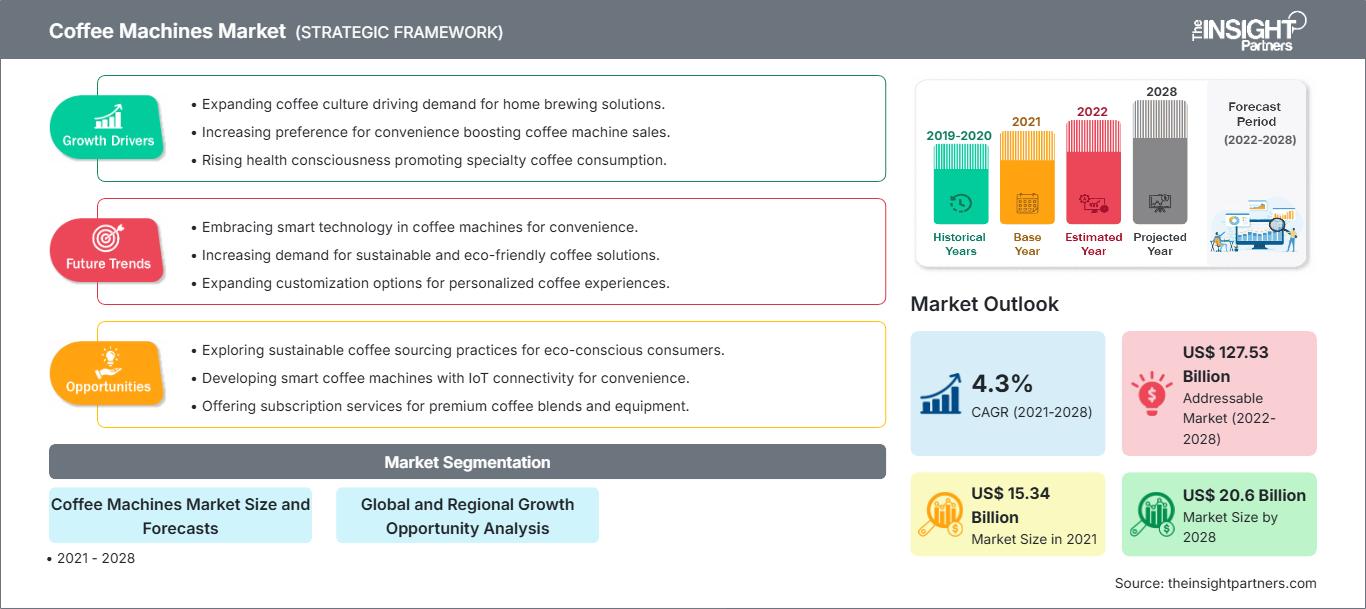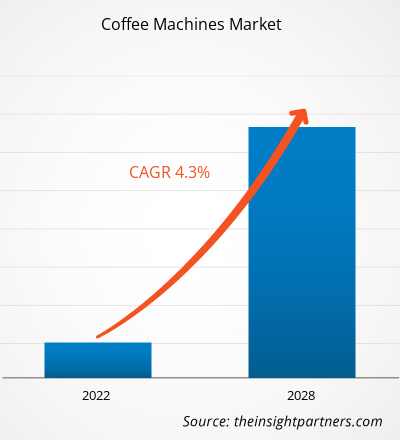[연구 보고서] 커피 머신 시장 규모는 2021년 153억 4,075만 달러로 평가되었으며, 2028년에는 205억 9,679만 달러에 이를 것으로 예상됩니다. 2021년부터 2028년까지 연평균 4.3% 성장할 것으로 예상됩니다.
시장 분석 및 분석가 의견:
커피 머신은 커피를 추출하는 데 사용되는 기기입니다. 프렌치 프레스, 에스프레소 커피 머신, 필터 커피 머신, 캡슐 및 포드 커피 머신 등 다양한 종류의 커피 머신이 있습니다. 각 머신은 서로 다른 메커니즘으로 작동합니다. 예를 들어, 필터 커피 머신은 물이 자동으로 가열 튜브로 떨어져 필터를 통과하는 분쇄 커피 위에 부어집니다. 반면, 캡슐 및 포드 커피 머신은 플라스틱이나 알루미늄으로 제작된 캡슐에 커피를 담아 작은 용기에 담아 커피 머신에 넣고 추출합니다. 기업 및 기관 부문 전반에서 커피 머신 수요가 증가하고 있습니다. 이러한 요인이 전 세계 커피 머신 시장을 크게 견인하고 있습니다.
성장 동력 및 과제:
지난 몇 년 동안 바쁜 업무 일정과 연장된 근무 시간으로 인해 사람들의 라이프스타일이 크게 변화했습니다. 빠르게 변화하는 라이프스타일로 인해 사람들은 점점 더 간편식과 음료를 선호하고 있습니다. 기업 부문에서는 사람들이 업무 관련 스트레스에 지속적으로 노출되어 동료 및 친구들과 함께 보낼 자유 시간을 찾고 있습니다. 커피는 풍부한 맛과 향으로 널리 소비되는 다용도 음료 중 하나입니다. 또한, 카페인 함량은 기분을 좋게 하고 동기를 부여하는 데 도움이 됩니다. 이러한 요인이 전 세계 커피 산업을 크게 견인하고 있습니다. 커피 머신은 즉석에서 커피를 추출할 수 있도록 해주기 때문에 기업 부문에서 커피 머신에 대한 수요가 높습니다. 이러한 요인이 커피 머신 시장을 크게 견인하고 있습니다. 하지만 커피의 중독성에 대한 인식이 높아짐에 따라 사람들은 커피를 천연 과일 주스, 버블티, 탄산수 등 다른 음료로 대체하고 있습니다. 또한, 과도한 카페인 섭취가 건강에 미치는 부정적인 영향에 대한 인식이 높아짐에 따라 개인 커피 수요도 저해되고 있습니다. 이러한 요인들은 커피 소비에 부정적인 영향을 미쳐 예측 기간 동안 커피 머신 수요를 저해할 것으로 예상됩니다.
요구 사항에 맞게 이 보고서를 사용자 정의하십시오.
이 보고서의 일부, 국가 수준 분석, Excel 데이터 팩을 포함하여 모든 보고서에 대한 사용자 정의를 무료로 받을 수 있을 뿐만 아니라 스타트업 및 대학을 위한 훌륭한 제안 및 할인을 이용할 수 있습니다
커피 머신 시장: 전략적 통찰력

- 이 보고서의 주요 주요 시장 동향을 확인하세요.이 무료 샘플에는 시장 동향부터 추정 및 예측에 이르기까지 데이터 분석이 포함됩니다.
이 보고서의 일부, 국가 수준 분석, Excel 데이터 팩을 포함하여 모든 보고서에 대한 사용자 정의를 무료로 받을 수 있을 뿐만 아니라 스타트업 및 대학을 위한 훌륭한 제안 및 할인을 이용할 수 있습니다
커피 머신 시장: 전략적 통찰력

- 이 보고서의 주요 주요 시장 동향을 확인하세요.이 무료 샘플에는 시장 동향부터 추정 및 예측에 이르기까지 데이터 분석이 포함됩니다.
보고서 세분화 및 범위
“글로벌 커피 머신 시장”은 유형, 범주, 최종 사용자 및 지역을 기준으로 세분화됩니다. 커피 머신 시장은 유형에 따라 필터 커피 머신, 에스프레소 커피 머신, 캡슐 및 포드 커피 머신 등으로 세분화됩니다. 범주에 따라 시장은 수동 및 자동, 반자동으로 분류됩니다. 최종 사용자를 기준으로 커피 머신 시장은 주거용과 비주거용으로 세분화됩니다. 커피 머신 시장은 지역에 따라 북미(미국, 캐나다, 멕시코), 유럽(독일, 프랑스, 이탈리아, 영국, 러시아 및 기타 유럽), 아시아 태평양(호주, 중국, 일본, 인도, 한국 및 기타 아시아 태평양), 중동 및 아프리카(남아프리카, 사우디아라비아, UAE 및 기타 중동 및 아프리카), 남아프리카로 세분화됩니다. 중앙아메리카(브라질, 아르헨티나, 기타 중남미 지역)
세분화 분석:
최종 사용자 기준으로 커피 머신 시장은 주거용과 상업용으로 구분됩니다. 주거용 부문은 커피 머신 시장에서 상당한 점유율을 차지했으며 예측 기간 동안 상당한 성장을 기록할 것으로 예상됩니다. 커피 소비 증가와 다양한 종류의 커피 로스트 및 브루에 대한 관심 증가는 주거 부문 전반의 커피 머신 수요를 견인하고 있습니다. 더욱이 COVID-19의 확산으로 사람들이 집에 머물도록 명령받았고 모든 외식 매장이 문을 닫았습니다. 이는 특히 선진국을 중심으로 가정의 커피 머신 수요를 증가시켰습니다. 이러한 모든 요인이 전 세계 커피 머신 시장을 잠재적으로 활성화하고 있습니다.
지역 분석:
지리적 측면을 기준으로 커피 머신 시장은 북미, 유럽, 아시아 태평양, 중남미, 중동 및 아프리카의 5개 주요 지역으로 나뉩니다. 전 세계 커피 머신 시장은 유럽이 주도했으며, 2022년 시장 규모는 49억 5,177만 달러였습니다. 북미는 세계 시장 점유율 20% 이상을 기록하며 두 번째로 큰 기여를 하고 있습니다. 아시아 태평양 지역은 예측 기간 동안 연평균 성장률 5% 이상의 상당한 성장을 기록할 것으로 예상됩니다. 북미 국가, 특히 미국에서의 일일 커피 소비량 증가는 커피 머신 수요를 견인하고 있습니다. 전미커피협회(NCA)에 따르면 미국인의 62%가 매일 커피를 마시는 것으로 나타났습니다. 또한, 빠른 라이프스타일로 인해 이동 중에도 커피를 마시는 추세가 증가함에 따라 북미 비주거 부문에서 커피 머신 수요가 증가하고 있습니다.
산업 개발 및 미래 기회
커피 머신 시장에서 활동하는 주요 업체들이 취한 다양한 이니셔티브는 다음과 같습니다.
- 2023년 3월, 유명 커피 머신 제조업체 중 하나인 De’Longhi는 커피 계량 및 추측 작업을 없애고 소비자가 신선하게 갈은 최상의 커피 경험을 즐길 수 있도록 하는 완전 자동 드립 커피 머신인 Truerew를 출시했습니다.
- 2020년 10월, Nespresso Professional은 COVID-19 팬데믹의 여파로 작업장의 안전을 강화할 Nespresso Momento 커피 머신에 새로운 비접촉식 기능을 출시했습니다.
- 2022년 3월, 호주에 본사를 둔 가정용 커피 장비 제조업체인 Breville Group은 이탈리아에 본사를 둔 프로슈머 Lelit의 인수를 발표했습니다. 에스프레소 장비 회사. Lelit의 가정용 에스프레소 커피 머신 포트폴리오는 Breville Group의 기존 가정용 커피 장비 포트폴리오를 보완합니다. 이번 인수를 통해 회사는 더 많은 고객층을 확보하고 소비자 도달 범위를 확대하며 매출을 증대할 수 있게 될 것입니다.
- 2021년 3월, De’Longhi는 스위스 커피 머신 제조업체인 Eversys의 나머지 60% 지분을 인수했습니다. 이 회사는 전자동 에스프레소 커피 머신 포트폴리오를 보유하고 있습니다. 이 회사 인수를 통해 De’Longhi는 제품 라인을 확장하고 다양한 지역의 많은 소비자를 만족시킬 수 있게 될 것입니다.
코로나19 영향:
코로나19 팬데믹은 여러 국가의 거의 모든 산업에 영향을 미쳤습니다. 북미, 유럽, 아시아 태평양(APAC), 중남미(SAM), 중동 및 기타 지역에서 봉쇄, 여행 제한 및 사업 중단이 발생했습니다. 아프리카(MEA)는 소비재 산업을 포함한 여러 산업의 성장을 저해했습니다. 제조 시설 폐쇄는 글로벌 공급망, 제조 활동, 배송 일정, 필수 및 비필수 제품 판매에 차질을 빚었습니다. 여러 기업들이 2020년에 제품 배송 지연과 제품 판매 부진을 경험했습니다. 팬데믹으로 인한 경기 침체로 소비자들은 구매 결정에 더욱 신중하고 까다로워졌습니다. 특히 개발도상국에서 소득 감소와 불확실한 수익 전망으로 인해 비필수품 구매가 크게 감소했습니다. 많은 커피 머신 제조업체는 팬데믹 초기 소비자 수요 감소로 수익 감소에 직면했습니다. 그러나 2021년 말까지 많은 국가가 백신 접종을 완료했고, 각국 정부는 봉쇄 및 여행 금지 등 특정 규제 완화를 발표했습니다. 사람들이 다양한 지역으로 이동하기 시작하면서 공항과 기차역의 커피 수요가 증가했고, 이는 커피 머신 수요를 증가시켰습니다. 이러한 모든 요인은 여러 지역의 커피 머신 시장 성장에 긍정적인 영향을 미쳤습니다.
커피 머신 시장 지역별 통찰력
The Insight Partners의 분석가들은 예측 기간 동안 커피 머신 시장에 영향을 미치는 지역별 동향과 요인들을 면밀히 분석했습니다. 이 섹션에서는 북미, 유럽, 아시아 태평양, 중동 및 아프리카, 그리고 중남미 지역의 커피 머신 시장 부문과 지역별 현황도 살펴봅니다.
커피 머신 시장 보고서 범위
| 보고서 속성 | 세부 |
|---|---|
| 시장 규모 2021 | US$ 15.34 Billion |
| 시장규모별 2028 | US$ 20.6 Billion |
| 글로벌 CAGR (2021 - 2028) | 4.3% |
| 이전 데이터 | 2019-2020 |
| 예측 기간 | 2022-2028 |
| 다루는 세그먼트 |
By 커피 머신 시장 규모 및 전망
|
| 포함된 지역 및 국가 | 북미
|
| 시장 선도 기업 및 주요 회사 프로필 |
|
커피 머신 시장 참여자 밀도: 비즈니스 역학에 미치는 영향 이해
커피 머신 시장은 소비자 선호도 변화, 기술 발전, 그리고 제품의 장점에 대한 인식 제고 등의 요인으로 인해 최종 사용자 수요가 증가함에 따라 빠르게 성장하고 있습니다. 수요가 증가함에 따라 기업들은 제품 라인업을 확장하고, 소비자 니즈를 충족하기 위한 혁신을 추진하며, 새로운 트렌드를 적극 활용하고 있으며, 이는 시장 성장을 더욱 가속화하고 있습니다.

- 을 얻으세요 커피 머신 시장 주요 주요 플레이어 개요
경쟁 환경 및 주요 기업:
글로벌 커피 머신 시장에서 활동하는 주요 기업으로는 Keurig Green Mountain, Inc., Robert Bosch GmbH, Electrolux AB, illycaffè SpA, Koninklijke Philips NV, Krups GmbH (Groupe SEB), Morphy Richards, Nestlé SA, Panasonic Corporation, LUIGI LAVAZZA SPA, De’Longhi Appliances Srl 등이 있습니다. 이러한 기업들은 혁신적인 기능과 추출 기술을 갖춘 최첨단 커피 머신을 제공하여 소비자에게 탁월한 커피 경험을 제공합니다.
- 과거 분석(2년), 기준 연도, CAGR을 포함한 예측(7년)
- PEST 및 SWOT 분석
- 시장 규모 가치/거래량 - 글로벌, 지역, 국가
- 산업 및 경쟁 환경
- Excel 데이터세트
최근 보고서
관련 보고서
사용 후기
구매 이유
- 정보에 기반한 의사 결정
- 시장 역학 이해
- 경쟁 분석
- 고객 인사이트
- 시장 예측
- 위험 완화
- 전략 기획
- 투자 타당성 분석
- 신흥 시장 파악
- 마케팅 전략 강화
- 운영 효율성 향상
- 규제 동향에 발맞춰 대응




















 무료 샘플 받기 - 커피 머신 시장
무료 샘플 받기 - 커피 머신 시장